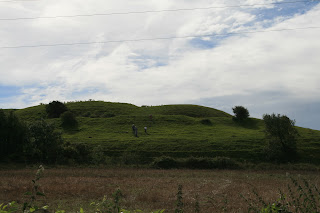A tin tabernacle, also sometimes known as a tin chapel, was a "temporary" building constructed from corrugated iron built during the late Victorian era and used for religious worship.
The late Victorian period was a time of religious missionary zeal and the Anglican church sought to spread the word particularly in rural areas such as Kent. Farm labourers and seasonal hop pickers would often find themselves living many miles walk from the nearest parish church.
To overcome this problem, tin tabernacles were built in the countryside as satellites of the parish churches. The minister would travel out to the tin tabernacle to deliver the Sunday sermon to the farm labourers and their families.
Although the tin tabernacles were only intended to be temporary structures in lieu of a more permanent building some can still be found in Kent well over one hundred years later.

The example pictured above was originally constructed in 1897 and located in Cuxton (near Rochester) but was dismantled and moved to the Museum of Kent Life in Sandling (near Maidstone) in 2000 where it is open to the public.

The tin tabernacles were usually very spartan inside as can be seen above.
 I came across the St Mary's Church Room in Sole Street by accident during a recent walk. As far as I can tell from looking at old Ordnance Survey maps it dates back to around 1880. Sole Street is a small rural village a few miles from Gravesend which grew up around the railway station which opened in 1861.
I came across the St Mary's Church Room in Sole Street by accident during a recent walk. As far as I can tell from looking at old Ordnance Survey maps it dates back to around 1880. Sole Street is a small rural village a few miles from Gravesend which grew up around the railway station which opened in 1861.
Although the tin tabernacles were only intended to be temporary structures in lieu of a more permanent building some can still be found in Kent well over one hundred years later.

The example pictured above was originally constructed in 1897 and located in Cuxton (near Rochester) but was dismantled and moved to the Museum of Kent Life in Sandling (near Maidstone) in 2000 where it is open to the public.

 I came across the St Mary's Church Room in Sole Street by accident during a recent walk. As far as I can tell from looking at old Ordnance Survey maps it dates back to around 1880. Sole Street is a small rural village a few miles from Gravesend which grew up around the railway station which opened in 1861.
I came across the St Mary's Church Room in Sole Street by accident during a recent walk. As far as I can tell from looking at old Ordnance Survey maps it dates back to around 1880. Sole Street is a small rural village a few miles from Gravesend which grew up around the railway station which opened in 1861.
Unusually for a tin tabernacle this one has a stained glass window.
 Lastly another one I came across by accident on a walk around Halstead. This is not technically at tin tabernacle as it is made from wood but interesting all the same! It is located in Otford Lane and was known as the Mission Church.
Lastly another one I came across by accident on a walk around Halstead. This is not technically at tin tabernacle as it is made from wood but interesting all the same! It is located in Otford Lane and was known as the Mission Church.
 Lastly another one I came across by accident on a walk around Halstead. This is not technically at tin tabernacle as it is made from wood but interesting all the same! It is located in Otford Lane and was known as the Mission Church.
Lastly another one I came across by accident on a walk around Halstead. This is not technically at tin tabernacle as it is made from wood but interesting all the same! It is located in Otford Lane and was known as the Mission Church.
At the time the church was constructed in 1891 most of Otford Lane lay in neighbouring Shoreham parish. Until that time the labourers and fruit pickers working on the farms and orchards there faced a walk of two or three miles to their proper parish church.
Eventually in 1938 Otford Lane was brought completely into Halstead parish. The Mission Church remained in use until 1985.
If you have enjoyed this post, you may also like....
























